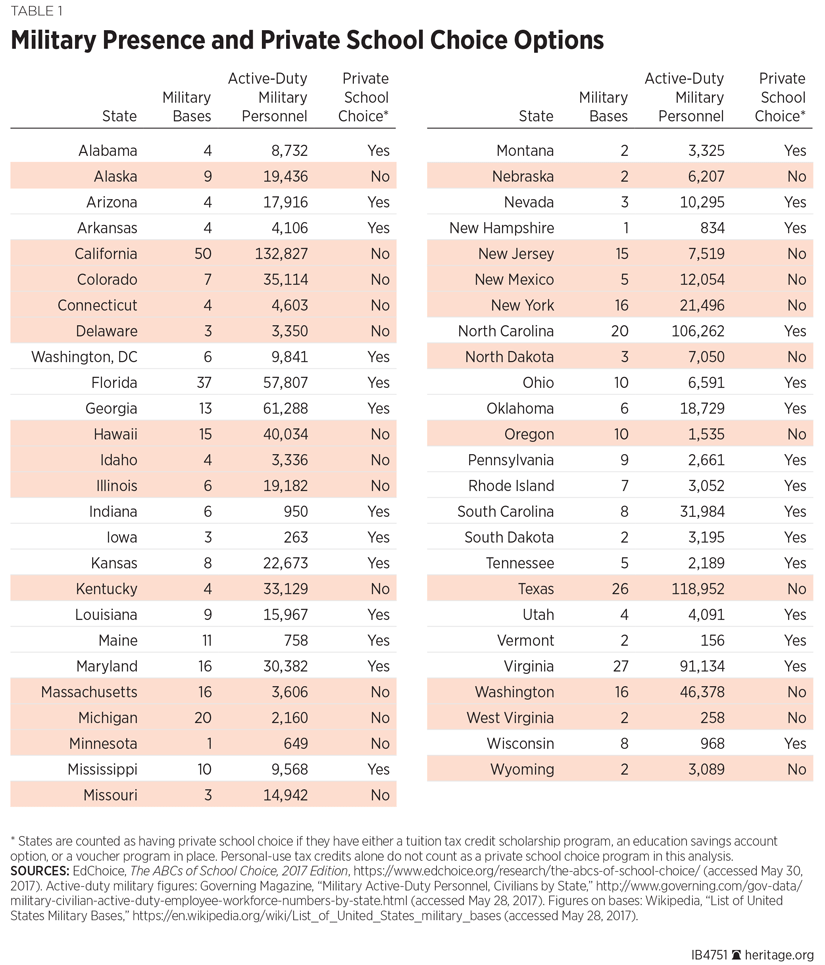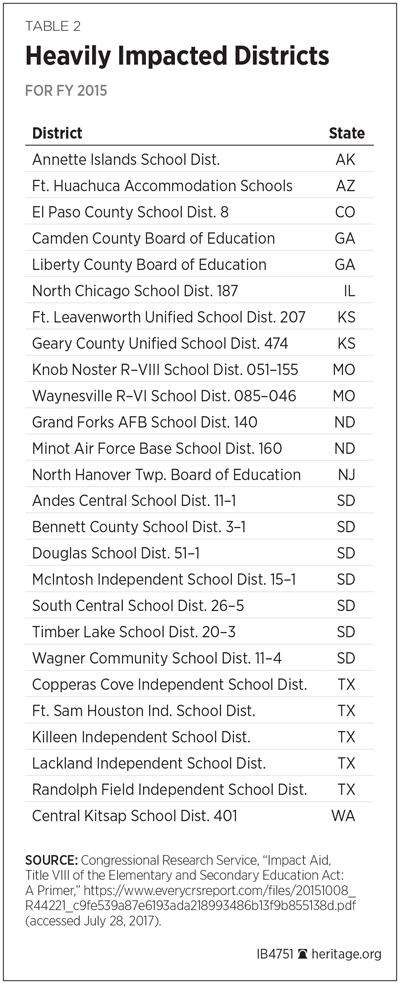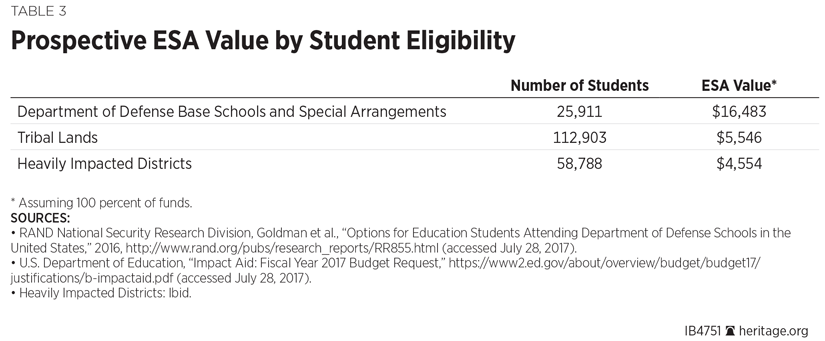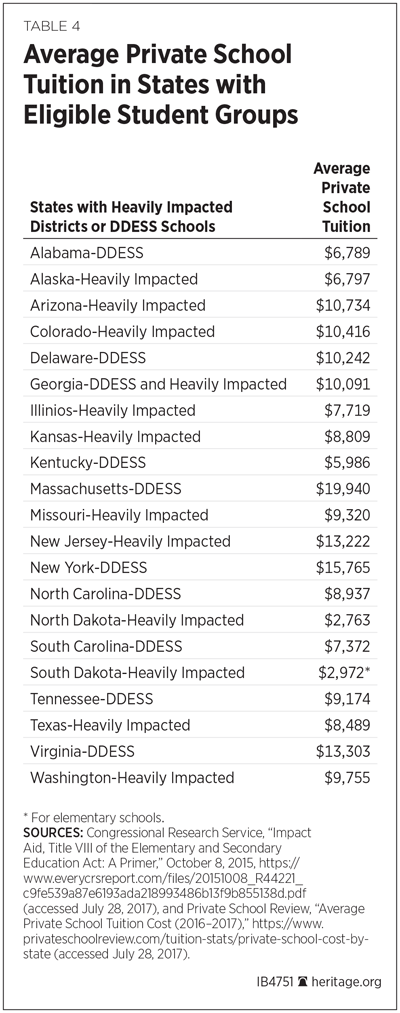Each year, the U.S. Department of Education (ED) distributes billions in taxpayer dollars to support the education of children for whom the federal government has a special responsibility. This group of federally connected children is the focus of the Department of Education’s Impact Aid program. Federally connected students, who number nearly 800,000, are primarily the children of military families, but some are children living on tribal lands and children of civilians who live or work on federal property such as military bases or national parks. Additionally, the federal government supports the education of military children by operating a system of base schools known as Department of Defense Elementary and Secondary Schools (DDESS) through a branch of the Department of Defense (DOD).
Although many aspects of military life have been modernized over the past century, the way in which the federal government supports the education of federally connected children has failed to keep pace with new education delivery models. Children of military families continue to be assigned to schools that may or may not meet their learning needs, consigning them to nearby district schools that are closest to their parents’ duty station. The federal government’s unique involvement with the education of federally connected children puts the onus on Congress to reform Impact Aid to ensure that it meets the needs of military-connected children and children who are otherwise federally connected.
This Issue Brief considers specific reforms for modernizing the Impact Aid program, transitioning it from a district-centric system to a student-centered program that provides eligible students with education savings accounts (ESAs). Within the existing system of DDESS schools and Impact Aid reimbursements, three student groups are eligible for enough funds to create robust ESAs through changes in federal policy: children living in “heavily impacted” districts, children from tribal lands, and children attending DDESS schools on base. In addition to changes in federal policy, state policymakers should also establish ESAs for military-connected children residing in their state.
Lack of Existing Education Options for Military-Connected Children and Children from Tribal Lands
According to a recent survey conducted and published by Military Times, 35 percent of respondents said that dissatisfaction with their child’s education was a “significant factor” in their decision to remain in or leave military service.[REF] The Pentagon’s changes to policy in 2016 enabling families to remain at duty stations for longer time periods was a direct response “to complaints by military parents who are loathe to move if the next duty station has poorly performing schools.”[REF] Those complaints may stem from the fact that military-connected children are too often assigned to the district schools closest to military bases.
Some 80 percent of the 1.2 million military-connected children who are school age attend traditional public schools, and more than half of active-duty military families live in states with no school choice options at all. Even those who are stationed in states with school choice programs are all too often limited by program eligibility. Lack of access to educational options also affects tribal communities. As Politico reported late in 2015, children from tribal lands are consistently trapped in the worst schools in the nation.[REF]

School Choice Through Federal Policy
The federal government’s exclusive responsibility and mandate to oversee national defense extends to military-related issues that impact education. The federal government also has a special responsibility toward children living on tribal lands and other federally connected children. While education is not an enumerated power of the federal government in the U.S. Constitution, in these two instances, the education of federally connected children has a special place as a ED program. Because it pertains to children of Native Americans and children of members of the armed services, Impact Aid is one of the few federal programs dealing with education that has constitutional warrant. As such, federal policymakers should work to modernize the way Impact Aid dollars are distributed. Instead of disbursing dollars to school districts to which children are then assigned, Congress should enable families to access funds in the form of flexible ESAs.
Education Savings Accounts
One of the most promising ways to advance school choice is through ESAs. ESAs are parent-controlled accounts funded with a portion of what would have been spent on their child in the district school system. Parents can then use their ESA funds to pay for any education-related service, product, or provider, including private school tuition, online learning courses, private tutoring, special education services and therapies, textbooks, curricula, and a host of other education options. Importantly, unused funds can also be rolled over from year to year. Extending this concept to the distribution of Impact Aid dollars, thereby empowering parents with control over the funds that are spent on their child, would create educational choice for federally connected children across the country, modernizing the Impact Aid program to better serve families.
Population of Federally Connected Students
Nearly 800,000 children in the United States are designated as federally connected students, and are the focus of the $1.3 billion federal Impact Aid program. Within this group, the ED directs funding to the areas and student groups based on a formula that considers local per pupil expenditures and local dependence on Impact Aid funding as well as the number and type of federally connected children present.
All Impact Aid dollars should be made portable, following children to education options of choice. However, due to the complexity of the formula used to allocate Impact Aid funding and to the diverse needs of local areas, some student groups—such as children from tribal lands and children in heavily impacted districts—generate the bulk of funding under the Impact Aid program, while other student groups generate a small amount of Impact Aid funding at the per-pupil level.
Three Primary Student Groups That Would Benefit from Modernizing Impact Aid
Within the existing system of DDESS schools and Impact Aid reimbursements, three student groups generate enough funds to create robust education savings accounts through changes to federal policy: children living in heavily impacted districts, children living on tribal lands, and children attending DDESS schools on base.
Children Attending Schools in Heavily Impacted Districts. During the 2016–2017 school year, nearly 59,000 students were educated in heavily impacted districts. Average per pupil Impact Aid funding per student attending a district school within a heavily impacted district exceeded $4,500 during the most recent school year.

Native American Children Living on Tribal Lands. More than 112,000 Native American children live on tribal lands and qualify for Impact Aid funding, the average per pupil amount of which exceeded $5,500 according to the most recent data available.
These two groups of students account for nearly $900 million of the $1.3 billion in total annual Impact Aid spending—roughly 70 percent. Taking the aggregate amount spent per group and establishing an average set per pupil allocation creates the baseline ESA amount that would be available to every student if his family chose to enter the ESA program.
Children Attending Department of Defense Domestic Dependent Elementary and Secondary Education Schools (DDESS). Nearly 26,000 students attend schools located on the base on which their family is stationed. However, the DOD is actively considering whether it should continue to operate a domestic school system or if a better alternative exists to provide quality education in a more cost-effective way.[REF] Overall, the DOD operates 57 DDESS schools on 15 bases in the contiguous United States, with average per pupil costs exceeding an estimated $16,000 per year.[REF]


Recommendations for Federal Policymakers
In order to expand the education options available to the children of members of the armed services and other federally connected children, federal policymakers should:
- Transition Impact Aid funding for heavily impacted districts into ESAs. Instead of filtering the $1.3 billion in federal Impact Aid funding to district schools and then assigning students to those schools based on where their parents are stationed, Impact Aid dollars should be directed to eligible students. All Impact Aid dollars for military-connected children in heavily impacted districts should go directly into a parent-controlled ESA, which the family could then use to pay for any education-related service, product, or provider that meets the specific needs of their child.
- Transition Impact Aid funding for children from tribal lands into ESAs. All Impact Aid money funding Native American children on tribal lands should be made available to parents in the form of ESAs. Families should be able to choose to access their Impact Aid funding in the form of an ESA, enabling them to choose learning options that work best for their children.
- Transition the DDESS system into a system of ESAs for military families. Rather than maintaining DDESS schools on military bases at great expense, the DOD should transition funding for DDESS schools into parent-controlled ESAs. Given the high average per-pupil expenditure at DDESS schools, the DOD could transition part of its current spending into flexible, parent-controlled accounts and use any savings to direct funds back to national defense priorities.
Recommendations for State Policymakers
Transitioning Impact Aid into a system of ESAs beginning with children attending school in heavily impacted districts and those living on tribal lands represents the bulk of spending under Impact Aid. The DOD should also transition funding for children who attend schools on base into a system of parent-controlled ESAs. Other students who generate Impact Aid funding should also be able to direct their money toward options that work for them. However, the lower per pupil amount provided to students who do not fall under one of these three categories necessitates a federal–state choreography where state and local leaders also establish robust school choice options. States should create ESAs for military-connected children and should ultimately move toward universal ESAs for all children.
In order to ensure that those who serve in the military to protect the U.S. are able to access the best possible educational options for their children, federal policymakers should work to empower children of military families with educational choice. Transitioning Impact Aid funding into parent-controlled ESAs would provide children of active-duty military and other federally connected families with educational choice and ensure that the federal program serves military families as well as they serve us.
—Lindsey M. Burke is the Will Skillman Fellow in Education and Director of the Center for Education Policy, of the Institute for Family, Community, and Opportunity, at The Heritage Foundation. Anne Ryland is a Research Assistant in the Center for Education Policy.


